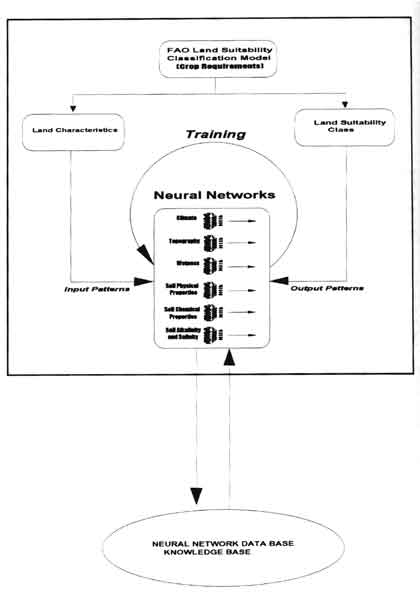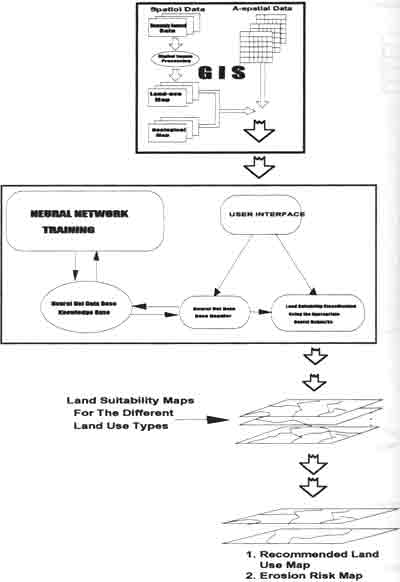| GISdevelopment.net ---> AARS ---> ACRS 1998 ---> Poster Session 1 |
A Land Evaluation System
Using Artifical Neural Network Based Expert's Knowledge and GIS
Joel C.
Bandibas1
1Research Center, Cavite State University,
4122 indang, Cavite, Phillppines
Tel: 046-4150020; Fax: 046-4150012,
E-mail:bandibas@gpu.sru.ualberta.ca
Abstract 1Research Center, Cavite State University,
4122 indang, Cavite, Phillppines
Tel: 046-4150020; Fax: 046-4150012,
E-mail:bandibas@gpu.sru.ualberta.ca
This study focused on the development a land evaluation expert systems without undergoing the tedious process of rules formulation. An automated land evaluation system with the transformation of land suitability classification expertise, following the FAO framework, into trained ANN. An error back-propagation ANNs model was used. The trained ANNs were stored in a data base, representing the knowledge base. This knowledge base was used in a land system successfully determined the best land suitability class in the area for com and rice cultivation.
Introduction
Land evaluation is a comprehensive assessment of the bio-physical properties of the land, in order to determine the best use of the area. It is a mulit-disciplinary research, which involves the creation of a data base composed of diverse and multi-criteria information. Consequently, and evaluation export systems using the rule based knowledge base is very difficult, inefficient and time consuming to develop because these requies the formulation of numerous rules or chains of rules (Bandibas, 1995). Indeed, the formulation of rules or chains of rules to store knowledge has been acknowledgement as the bottleneck during expert system development and design.
An alternative method to capture experts knowledge without using rules is the use of ANN. ANN can be trained to process information and to represent knowledge in it (Aleksander and Morton, 1989) Indeed, recent studies suggest that ANN can be trained to identify complex patterns of information and relate them to a certain phenomenon or an object.
The main objective of this study is to develop a land evaluation expert systems without using a rule-based knowledge base. Specifically, this study focused on the development of a GIS linked automated land evaluation system using trained ANN as the knowledge base. A methodology of transforming a land evaluation expertise into trained ANN was developed. An ANN architecture and training scheme were formulated.
ANN Training and the Fao Framework
In this study, the ANNs were trained to simulate the FAO land suitability classification framework wherein the the land's physico-chemical properties (land characteristics) are divided into six groups namely:
- Climatic characteristics;
- Topographic/rish to erosion factors;
- Factors affecting wetness of the soil;
- Physical soil characteristics;
- Soil fertility characteristics;
- Salinity and alkalinity
The ANN used in this study has three layers representing the input, the hidden and the output. The number of nodes in the input layer depends upon the number of a corresponding neural network. All of the six network has five output nodes and five possible output training patterns. These five output patterns correspond to the five land generate one of the output pattern based on the values of the inputs. For example, if the input pattern of climatic characteristic is
| Length of the growing period (days) | : | 130 |
| Rainfall, growing cycle (mm) | : | 560 |
| Mean temperature | : | 22 |
| Mean minimum temperature | : | 16.5 |
| Sunshine (n/N) | : | 0.50 |
| Climatic hazards | : | 1 (none) |
Which are highly suitable (S1) values for rainfed com production, the training input and output patterns should be like the one shown in the following figure.


Figure 1. Summary of the ANNs training scheme
| Suitable (S1) | Moderately Suitable (S2) | Marginally Suitable (S3) | Potentially Suitable (N1) | Unsuitable (N2) |
| 1 | 0 | 0 | 0 | 0 |
| 0 | 1 | 0 | 0 | 0 |
| 0 | 0 | 1 | 0 | 0 |
| 0 | 0 | 0 | 1 | 0 |
| 0 | 0 | 0 | 0 | 1 |
Figure 2 shows the data structure used in this study and the flow of information form the GIS to the ANN during training and actual land suitability classification.

Figure 2. The data structure and the flow of information from the GIS to the ANN (the values used are hypothetical).
Land Suitability Classification using the Trained ANNs
The trained neural networks were used to classify the land suitability for a desired land use type of an area in Quirino province, Philippines. Figure 3 shows the summary for the classification process. The user interface involves the determination of summary of the classification process. The user interface involves the determination of the land use type and the selection of the appropriate trained neural networks in the knowledge base. The physico-chemical soil parameters were automatically extracted from the GIS as shown in Figure 2 for the land suitability class determination. Through these processes, the different land suitability class maps corresponding to the different land use type were generated. These maps were then used to determine the land use type which has highest suitability class maps corresponding to the different land use types were generated. These maps were then used to determine the land use type which has the highest suitability class (using overlay method) which will then be selected as the recommended type of land use.

Figure 3. Automated land evaluation using the trained neural networks.
Result and Discussion
The land evaluation knowledge base in the form of trained neural network was successfully generated. This involved the use of the different crop requirement tables (following the FAO land suitability classification framework) of the different land use types for the different land use types for the training of the ANNs. The trained ANNs were successfully used for the land suitability classification of the different land use types of the study area in the northern Philippines. This is clearly shown in the resulting maps in Figure 4. Indeed, it is very apparent that the differences between figures 4a and 4b, showing the land suitability maps for com cultivation obtained using the rule based method and the ANN, respectively, are almost indistinguishable. The same is true in figures 4c and 4d, showing the land suitability maps for rice cultivation using the two methods. Indeed, using the neural network data base, the system was able to give the best possible land use type of the different land units in the study area.

Figure 4. Land suitability maps for rainfed corn cultivation obtained (a) using the rule based method and (b) the ANN land suitability maps for rainfed rice cultivation obtained using the (c) rule based method and (d) the ANN.
Conclusion
A methodology for the transformation of a land evaluation expertise form a rule base to trained ANNs was successfully developed. This includes the design of the ANN architecture and training scheme. The use of these trained ANNs during the actual land evaluation was successful. A GIS linked automated land evaluation system was successfully developed with knowledge base composed of the trained ANNs.
Reference
- Alexander, I. and H. Mortion. 1990. An Introduction to Neural Computing. Chapman and Hall, London. 237 pp.
- Bandibas, J.C. 1986. The automated land evaluation using artificial neural network based expert's knowledge, GIS and remotely sensed data. Spatial and spectral signatures for satellite image classification. PhD. Thesis. Geologisch Institute, University Gent, Belgium. 201 pp.
- Rumelhart, D.E., G.E. Hintron and R.J. Williams. 1986. Learning Internal Representations by Error Propagation in Parallel Distributed Processing. MIT Press, Massachusetts. Vol. 1 and 2.